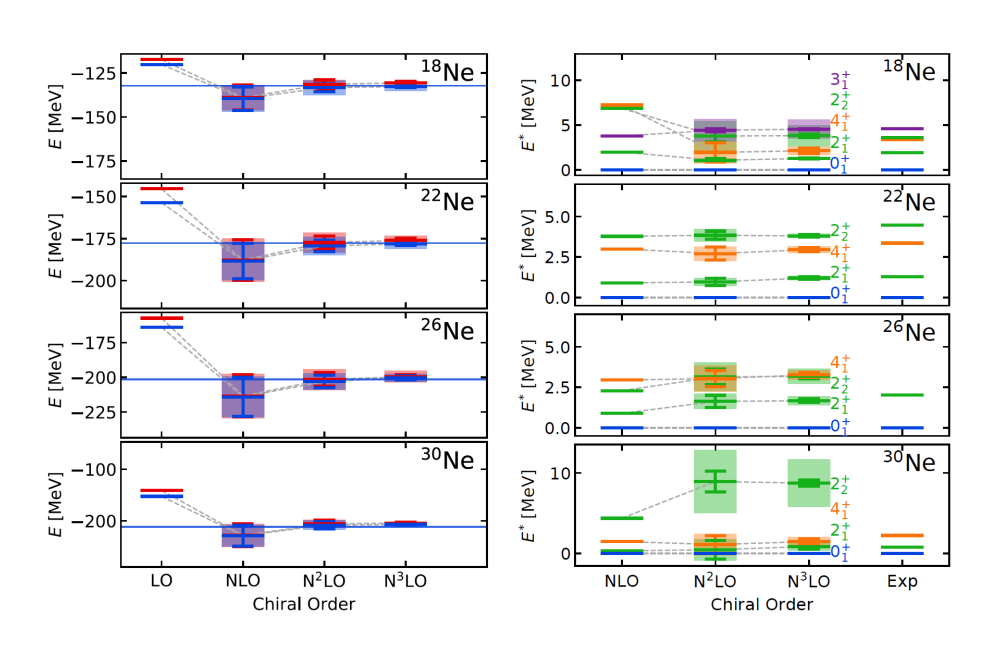Fully Open-Shell Medium-Mass Nuclei and Electromagnetic Observables for Ab Initio Nuclear Structure IV
Einleitung
The ab initio description of medium-mass nuclei is one of the most dynamic frontiers in nuclear structure theory. One many-body approach in particular, the In-Medium Similarity Renormalization Group, has become a powerful and flexible tool for the description of the full portfolio of nuclear structure observables. In this framework, we have developed the In-Medium No-Core Shell Model, which provides access to ground and exited-state observables of closed and open-shell nuclei up into the intermediate mass regime. This allows us to connect the underlying physics of the strong interaction, captured in chiral effective field theory, with nuclear structure observables in the regime of stable and exotic nuclei that are being studied experimentally at several labs worldwide, including FAIR/GSI.
Methoden
Ergebnisse
We have focused on the characterization and application of new families of chiral two plus three-nucleon interactions form chiral effective field theory. We have explored two specific families of interactions with different regulator schemes, nonlocal and semilocal regulators, and a range of chiral truncations from leading order to next-to-next-to-next-toleading order and beyond. This enables a systematic quantification of the theory uncertainties resulting from the truncation of the chiral expansion using sophisticated Bayesian methods. Furthermore, the control over all relevant truncations of the many-body model space enables the quantification of the many-body truncation uncertainties. Although this explicit uncertainty quantification increases the computational cost by about one orderof- magnitude, it is vital for confronting ab initio predictions of nuclear observables with experiment. We have explored this scheme based on the IM-NCSM for several mediummass nuclei, mainly in the oxygen, neon, and magnesium isotopic chains from stable isotopes to the driplines. We have focused on ground-state and excitation energies, charge radii, and low-lying and collective transition strengths. The latter includes an additional methodological development, where we replace the NCSM diagonalization with an equations-of-motion method. Among the highlight publications resulting from this project are two joint papers with experimental groups on charge radii in nickel isotopes, two papers on collective excitations in medium-mass nuclei, and one comprehensive paper with the LENPIC collaboration on the latest results with semilocal interactions and advanced Bayesian uncertainty quantification schemes.
Diskussion
Our studies demonstrate the predictive power of modern ab initio methods based on chiral effective theory inputs, but they also reveal some deficiencies that will be the subject of future investigations. We have shown that nonlocal NN+3N interactions allow for a robust prediction of ground-state and excitation energies in the p and sd-shell which agree with experiment within the theoretical uncertainties. Also charge radii are well reproduced with the nonlocal family of chiral interactions. For semilocal interactions, however, we observe a significant underestimation of charge radii beyond the light nuclei, although ground-state energies are still in good agreement with experiment. Since we have full control over the many-body uncertainties in the IM-NCSM, we can clearly identify the chiral inputs as origin of this discrepancy. Such regulator-scheme dependencies of selected nuclear observables are unexpected and will be analyzed in more detail in future studies. Furthermore, our studies also reveal limitations of the IM-SRG framework itself. Particularly for electric quadrupole observables, we observe increased many-body uncertainties for specific isotopes. In these cases, the reference states used for the multi-reference IM-SRG decoupling are missing important static correlations. Based on these observations we are planning to extend the IM-NCSM framework to allow for a more flexible refence-space truncation. We will develop an active-space configuration interaction approach combined with the multi-reference IM-SRG to capture important static correlations from the outset. This follow-up project will be a central part of our research activities in the third funding period of the DFB SFB 1245.




